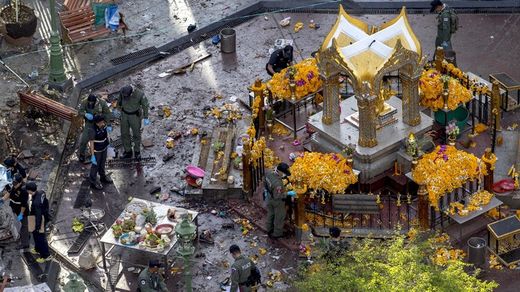Cui bono: Who benefits from the Bangkok bombing?
Pepe Escobar
Asia Times
The Guy in the Yellow T-shirt — long shorts, unruly black hair, thick dark glasses — arrived at the Erawan shrine in a tuk-tuk. No one may have noticed him; just another nondescript backpacker in one of the busiest crossroads in Asia. He may have come to pay his respects to the golden statue of Brahma at the center of the shrine – and gaze on the Thai dancers and musicians in the background.
He sits on a bench. Then, slowly, he gets rid of a black backpack. He stands up, checks his mobile. Then he walks away. Stops. Actually seems to be calling someone on his mobile. Then he finally leaves Erawan, hitting the crowded intersection, clutching a white plastic bag, but always checking his phone.
He may – or may not – have known all his movements were being tracked by multiple CCTV cameras. A few minutes after he disappears from their sights, and allegedly takes a motorbike taxi, he enters, with a lethal bang, the wilderness of mirrors that is contemporary Thailand.
Who is he? Thai police is convinced he is none other than the Bangkok Bomber. And there seem to be no other prime CCTV-captured candidates.
The first leak described him as an “Arab-like man”. That’s quite vague – as there is a huge, bustling mini-Middle East only two Skytrain stations away from the Erawan shrine. But that was enough to ring all al Qaeda/ISIS bells across the planet.
Then a quote was wrongly attributed to General Prime Minister Prayuth Chan-ocha, the head of the – quaintly Orwellian – National Council for Peace and Order which rules over Thailand after a coup in May 2014. Prayuth was actually referring to someone else when he stated that the suspect was believed to be a northeast-based Red Shirt member – as in a faithful follower of self-exiled, corruption-tainted, billionaire tycoon/former prime minister Thaksin Shinawatra.
And that’s Thai wilderness of mirrors in full regalia. The Guy in the Yellow T-shirt may be an Arab terrorist; he may be an indigenous anti-military Red Shirt operative; he might even be something in between – a Thai Muslim separatist.
The blowback dervish dance
Royal Thai Army chief and Deputy Defense Minister General Udomdej Sitabutr stressed the 3 kg pipe bomb at the Erawan shrine did “not match” the tactics of Muslim separatist rebels in Thailand’s Deep South, even though there has been a recent surge of IED attacks (27 in July alone), but just confined to the Deep South.
Thailand’s Muslim guerrilla is all about separatism – not religion. The key guerrilla outfit is the Barisan Revolusi Nasional (BRN). What they want is essentially full autonomy for Thailand’s three southern border provinces—Pattani, Narathiwat and Yala.
So this may not be prime al-Qaeda-style Jemaah Islamiyah territory, not to mention ISIS/ISIL/Daesh; what conservative Muslim clerics in the Deep South worry about is Thai cultural imperialism.
But that does not preclude, of course, insidious attempts at hardcore Islamization; and combative Salafi-jihadis gestated by their Wahhabi matrix are quite adept at that. By the way Jemaah Islamiah, on the record, fully supports Muslim separatism in Thailand. And the separatists and the military junta in Bangkok are not talking – “peace” or otherwise.
Is The Guy in a Yellow T-Shirt a Uyghur? The connection remains plausible – as the Erawan shrine is extremely popular among Chinese (and most Asians, for that matter). Thailand was rocked last month by a Uyghur scandal; more than 100, suspected of “terrorism” by Beijing, were deported to China.
It’s a fact there is a Uyghur connection in the Deep South itself; that’s a training stopover, after they leave Western China to their idealized future as “moderate rebels” in Syria. Some of the deported were indeed planning to wage jihad in “Syraq,” as Beijing intel was convinced. Hardly surprising that Chinese TV showed them on the plane back to China enveloped by black hoods.
The proverbial blowback dervish dance followed; an attack on the Thai consulate in Turkey. With the proverbial American connection; the attack was coordinated by the World Uyghur Congress, which is essentially financed by the now-banned-in-Russia NED and supported by the Nulandistan faction of the State Department.
Timing and location, location, location
The Guy in the Yellow T-shirt certainly has a gift for timing. Assuming he’s the real Bangkok Bomber, he turned the self-described “City of Life” into a city of death only one day after hundreds of thousands of Thais in blue shirts cycled across the city in the Bike for Mom spectacular; a two-wheeled homage to the Queen’s birthday, led by Crown Prince Maha himself.
And that’s where the wilderness of mirrors unveils — or reflects — the Thai royal succession. Since the coup in May 2014, General Prime Minister Prayuth’s pride and joy has been to provide Thailand with some sort of stability. Yes, this is a military junta — but most people at least in Bangkok are not complaining; compared to the nasty polarization — and appalling violence — of the past decade, this looks and feels like a five-star spa. The price was paid by democracy; crackdown on all forms of political protest, silencing — or ignoring — the opposition as a whole, a wave of arrests.
But now the going gets tougher. Last year, General Prime Minister Prayuth was saying that democracy would be back by October 2015, two months from now. A new road though map spells out elections only – maybe — by 2017.
The draft of a new constitution is due to be voted next month by the — also quaintly Orwellian — National Reform Council. And a public referendum may – or may not – happen in January 2016.
This is all supposed to be in place in case the royal succession is relatively imminent. Revered King Bhumibol’s health is faltering, and the Crown Prince’s public profile displayed in full — and fun — regalia at the Bike for Mom spectacular is part of the softening of the transition. Key subtext; all avenues for Thaksin Shinawatra and his Red Shirt army to plan a comeback must be closed a.s.a.p.
Stability? What stability?
The Bangkok bombing’s day after was marked by yet another IED, this one thrown from a bridge across the Chao Praya river. It missed a boat and the bustling Sathorn pier — very close to the Shangri-La hotel — by a whisker and exploded in the water. The target, once again: global tourists and local civilians, echoing Defense Minister Prawit Wongsuwan’s substantially correct initial verdict at the Erawan shrine; “The perpetrators intended to destroy the economy and tourism.”
And that may point to the military junta’s ultimate nightmare; what if The Guy in the Yellow T-shirt detonated a rolling campaign to target all Bangkok’s top tourist magnets?
Thailand is not exactly stagnated; according to Credit Suisse it may grow 2.5% this year — not shabby in a downward global economy. But no less than two-thirds of this GDP growth comes from tourism. And tourism from Asia. Hong Kong has already issued a red alert on travel to Thailand.
Out of the fatal victims at Erawan, there are, so far, apart from five Thais, three Chinese, two Hong Kong residents, two Malaysians, one Singaporean, one Indonesian and one Filipino. Many of the wounded are from China and Taiwan. Special booths near the shrine were set up with plenty of Chinese translators to help the victims, relatives and even Chinese media.
What’s certain is that The Bangkok Bomber already smashed the junta’s credibility. What kind of “stability” is that when the military could not see it coming – the largest, deadliest terrorist attack in the history of Bangkok?
The next step may well be round up the usual (Red Shirt) suspects. As in the leaders/faithful road warriors of the deposed (twice) Shinawatra clan.
A pipe bomb packed with 3kg of TNT and wrapped in cloth has precedents. Only six months ago two small pipe bombs exploded near the upscale Siam Paragon mall, not far from the Erawan shrine. Responsibility was attributed to the red shirts. That happened only one month after a national assembly — controlled by the General Prime Minister — decided that the former spectacularly inefficient prime minister Yingluck Shinawatra should be excluded from politics for five years.
And one of two suspects who fired grenades at Thailand’s Criminal Court building earlier this year happened to be close to Thaksin’s cousin, Chaiyasit Shinawatra.
Yet don’t forget the wilderness of mirrors. Bangkok’s velvet corridors have been shaken by rumors of a counter coup. There are factions not exactly amused by the General Prime Minister too comfortably settling down in the power seat; and most of all, these factions are increasingly incensed by the very close Bangkok-Beijing relationship.
If the shady forces controlling The Guy in the Yellow T-shirt thought they could masquerade the Erawan massacre as a Deep South-style IED blast, it didn’t stick. We already know the losers: Thailand’s fragile unity; Thailand’s economy — heavily dependent on tourism; and the geopolitical Big Prize: the multilayered Thai-Chinese relationship, which includes several instances of the New Silk Road(s).
But we still don’t know who employed The Guy in the Yellow T-shirt. Is he a red shirt? Is he a jihadi-to-be indoctrinated and trained by the usual suspects? Is he – oh, the sweet smell of conspiracy! – a CIA black ops in cahoots with the new US ambassador in Thailand, Glyn Davies, a specialist in “non-military force” to advance regime change options (or Thailand’s essential vote in favor of the anti-China TPP)?
The Guy in the Yellow T-shirt, lost in a wilderness of mirrors, may have some answers. But please don’t go cowboy and ask questions later.


